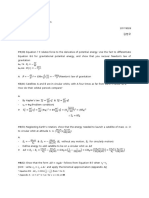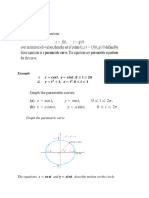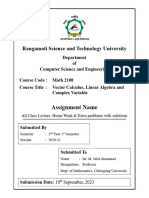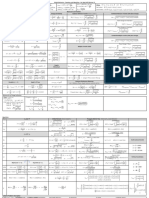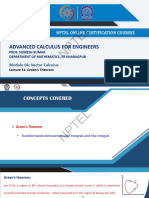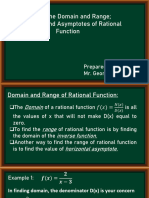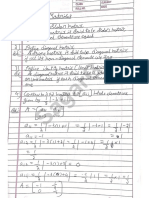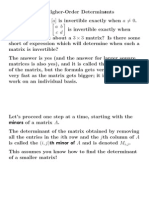140203Spring_LinearAlgebra_solution
Uploaded by
yalda.hajilito140203Spring_LinearAlgebra_solution
Uploaded by
yalda.hajilitoIn the name of Goodness
Midterm Exam of Linear Algebra
Spring 2024 (2nd semester of 1402-03)
Computer Sci. & Eng. & I.T. dept., Elec. & Comp. Eng. School, Shiraz University
Exam date: 2-May-24 (13/2/1403) Exam Time: 14:00 Exam Duration: 90 min.
1- Consider four matrices 𝐴ℳ×𝒩 , 𝐵𝒵×𝒲 , 𝐶𝒵×𝒩 , 𝐷ℳ×𝒲 .
a. Make a block matrix 𝐸 by them.
𝐴𝐷 𝐷𝐴 𝐶𝐵 𝐵𝐶
𝐸=[ ] 𝑜𝑟 [ ] 𝑜𝑟 [ ] 𝑜𝑟 [ ]
𝐶𝐵 𝐵𝐶 𝐴𝐷 𝐷𝐴
b. How many possible forms 𝐸 can have? Four solutions as shown above
c. What is its size? (ℳ + 𝒵) × (𝒩 + 𝒲)
d. Consider 𝐸 as an adjacency matrix of a directed graph 𝐺. What is the relation between
ℳ, 𝒩, 𝒵 & 𝒲? ℳ + 𝒵 = 𝒩 + 𝒲
e. By adding a new vertex to 𝐺 with no edge to previous vertices whereas all of them have
connected to this new vertex, what is the form of new adjacency matrix as a block matrix
of 𝐴, 𝐵, 𝐶, 𝐷 & … ?
𝐴 𝐷 1 ⃗ℳ
[𝐶 𝐵 ⃗1𝒵 ]
⃗0𝒩 ⃗0𝒲 0
2- Given an 𝒩-vector 𝑥 , try to make it zero-mean step by step.
a. Finaly compute a matrix 𝐻𝒩×𝒩 such that 𝐻𝑥 is the zero-mean form of 𝑥 .
⃗1𝑇 𝑥
𝑥̅ =
𝒩
⃗ 𝑇𝑥
1 ⃗1
1 ⃗𝑇 𝟏𝒩×𝒩
𝑥0 = 𝑥 − 1 ⃗ 𝑥̅ = 𝑥 − 1⃗ ( )=𝑥− 𝑥 = (𝐼𝒩×𝒩 − ) 𝑥 = 𝐻𝒩×𝒩 𝑥
𝒩 𝒩 𝒩
b. Compute the null-space of 𝐻.
𝑛⃗0 = 𝐻𝑛⃗ = 0⃗ ⇒ 𝑛⃗ − 1 ⃗ 𝑛̅ = 0⃗ ⇒ 𝑛⃗ = 1⃗ 𝑛̅ 𝑎𝑛𝑦 𝑣𝑒𝑐𝑡𝑜𝑟 𝑤𝑖𝑡ℎ 𝑐𝑜𝑛𝑠𝑡𝑎𝑛𝑡 𝑒𝑙𝑒𝑚𝑒𝑛𝑡𝑠 𝑛̅
A vector space along 1 ⃗.
c. What is the rank of 𝐻?Why?
The rank of null space (nullity) is one so the rank of 𝐻 is 𝒩 − 1
d. Prove or show that 𝐻 is idempotent (i.e. 𝐻 × 𝐻 = 𝐻)
∀𝑥 : 𝐻 × 𝐻 × 𝑥 = 𝐻 × 𝑥 0 = 𝑥 0 = 𝐻 × 𝑥
⇒ ∀𝑥 : 𝐻𝐻𝑥 = 𝐻𝑥 ⇒ 𝐻𝐻 = 𝐻
𝑜𝑟
𝟏𝒩×𝒩 𝟏𝒩×𝒩 2(𝟏𝒩×𝒩 ) (1⃗ ⃗1𝑇 )(1
⃗ ⃗1𝑇 )
𝐻𝐻 = (𝐼 − ) (𝐼 − )=𝐼− +
𝒩 𝒩 𝒩 𝒩2
2(𝟏𝒩×𝒩 ) ⃗1(1
⃗ 𝑇 ⃗1)1⃗𝑇 2(𝟏𝒩×𝒩 ) ⃗1(𝒩)1⃗𝑇 2(𝟏𝒩×𝒩 ) 𝟏𝒩×𝒩
=𝐼− + 2
= 𝐼 − + 2
=𝐼− +
𝒩 𝒩 𝒩 𝒩 𝒩 𝒩
𝟏𝒩×𝒩
=𝐼− =𝐻
𝒩
3- Assume 𝐴 & 𝐵 are outer product of 𝑎 by 𝑎 and 𝑏⃗ by 𝑏⃗, respectively (𝑒. 𝑔. 𝐴 = 𝑎𝑎𝑇 ). Prove that
square of inner product of 𝑎 & 𝑏⃗ is equal to 𝑡𝑟(𝐴𝐵).
2
𝑡𝑟(𝑎𝑎𝑇 𝑏⃗𝑏⃗ 𝑇 ) = 𝑡𝑟 ((𝑏⃗ 𝑇 𝑎)(𝑎𝑇 𝑏⃗)) = (𝑏⃗ 𝑇 𝑎)(𝑎𝑇 𝑏⃗) = (𝑎𝑇 𝑏⃗)
4- Describe at least four differences between Gauss-Elimination and Gram-Schmidt algorithms. For
example: form of independent vectors, need to pivoting, need to scaling residue, capability of
parallel computing the coefficients.
Gauss-Elimination Gram-Schmidt
Form of independence Echelon Orthonormal
Pivoting May need No
Residue scaling (normalization) No Yes
Parallel coefficient computing No Yes
Good Luck
M. Taheri
You might also like
- Easy Notes On Mechanics Moment of Inertia PDF0% (2)Easy Notes On Mechanics Moment of Inertia PDF48 pages
- Math4424: Homework 4: Deadline: Nov. 21, 2012No ratings yetMath4424: Homework 4: Deadline: Nov. 21, 20122 pages
- Lecture 11_Stochastic Regressors Measurement ErrorsNo ratings yetLecture 11_Stochastic Regressors Measurement Errors6 pages
- Application of Partial Differential EquationsNo ratings yetApplication of Partial Differential Equations7 pages
- Engineering Math Rule Summary (Week 1 To 6)No ratings yetEngineering Math Rule Summary (Week 1 To 6)9 pages
- PEP 2021 Phase 1 Selection Test 2 - SolutionNo ratings yetPEP 2021 Phase 1 Selection Test 2 - Solution8 pages
- 2nd Year Maths Chapter 3 Soulution NOTESPKNo ratings yet2nd Year Maths Chapter 3 Soulution NOTESPK48 pages
- Orbital Mechanics Reference Sheets Equations and Algorithms 1689515592No ratings yetOrbital Mechanics Reference Sheets Equations and Algorithms 16895155922 pages
- Estimation of Mean Vector and Variance Covariance Matrix PDFNo ratings yetEstimation of Mean Vector and Variance Covariance Matrix PDF7 pages
- MVC Week 3 Lecture (Vector Equalition of Plane and Its Distance)No ratings yetMVC Week 3 Lecture (Vector Equalition of Plane and Its Distance)9 pages
- DR Lara Abou Orm Calculus III Hyperbolic Functions, Inverse Trigonometric Functions, SeriesNo ratings yetDR Lara Abou Orm Calculus III Hyperbolic Functions, Inverse Trigonometric Functions, Series4 pages
- MAT-250 - Chapter 15 (Excluding 15.8. It Comes Later)No ratings yetMAT-250 - Chapter 15 (Excluding 15.8. It Comes Later)53 pages
- Lecture-09 Line Integration Conservative Field StudentNo ratings yetLecture-09 Line Integration Conservative Field Student7 pages
- Domain and Range, Intercepts, Asymptotes of Rational FunctionNo ratings yetDomain and Range, Intercepts, Asymptotes of Rational Function20 pages
- Baby-Bow-Bunny-Crochet-Pattern-Step-by-Step100% (1)Baby-Bow-Bunny-Crochet-Pattern-Step-by-Step5 pages
- Pochacco-Christmas-Reindeer-Crochet-PDF-PatternNo ratings yetPochacco-Christmas-Reindeer-Crochet-PDF-Pattern6 pages
- LU Decomposition: (Chapter 20, Section 20.2 Kreyszig)No ratings yetLU Decomposition: (Chapter 20, Section 20.2 Kreyszig)3 pages
- Eigenvectors of Real and Complex Matrices by LR and QR TriangularizationsNo ratings yetEigenvectors of Real and Complex Matrices by LR and QR Triangularizations24 pages
- NCERT Solutions Class 12 Math Chapter 3 MatricesNo ratings yetNCERT Solutions Class 12 Math Chapter 3 Matrices35 pages
- Solution of Systems of Linear EquationsNo ratings yetSolution of Systems of Linear Equations48 pages
- Matrices JEE Main 2021 (July) Chapter-Wise QuestionsNo ratings yetMatrices JEE Main 2021 (July) Chapter-Wise Questions9 pages
- Matrices and Determinants by (Question Bank) SagarGNo ratings yetMatrices and Determinants by (Question Bank) SagarG10 pages
- 9th Math Notes Solved Compiled by Urdu Books GroupNo ratings yet9th Math Notes Solved Compiled by Urdu Books Group97 pages
- The Beginnings of Matrices and Determinants Goes Back To The Second Century BC Although Traces Can Be Seen Back To The Fourth Century BCNo ratings yetThe Beginnings of Matrices and Determinants Goes Back To The Second Century BC Although Traces Can Be Seen Back To The Fourth Century BC2 pages
- Distance of A System From A Nearest Singular Descriptor System Having Impulsive Initial-ConditionsNo ratings yetDistance of A System From A Nearest Singular Descriptor System Having Impulsive Initial-Conditions6 pages
- The Fundamental Theorem of Linear Algebra 1993No ratings yetThe Fundamental Theorem of Linear Algebra 19939 pages
- Linear Algebra: DR Siti Ainor Mohd YatimNo ratings yetLinear Algebra: DR Siti Ainor Mohd Yatim21 pages
- New Method To Calculate Determinants of N X N (N Geq 3) Matrix, by Reducing Determinants To 2nd OrderNo ratings yetNew Method To Calculate Determinants of N X N (N Geq 3) Matrix, by Reducing Determinants To 2nd Order16 pages
- Download ebooks file Matrix Computations Fourth Edition Gene H. Golub all chapters100% (12)Download ebooks file Matrix Computations Fourth Edition Gene H. Golub all chapters50 pages
- MATH1031 Mathematics For Life Sciences: Term 3, 2021No ratings yetMATH1031 Mathematics For Life Sciences: Term 3, 202110 pages












